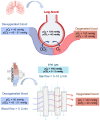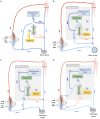Trends, Advantages and Disadvantages in Combined Extracorporeal Lung and Kidney Support From a Technical Point of View
- PMID: 35800469
- PMCID: PMC9255675
- DOI: 10.3389/fmedt.2022.909990
Trends, Advantages and Disadvantages in Combined Extracorporeal Lung and Kidney Support From a Technical Point of View
Abstract
Extracorporeal membrane oxygenation (ECMO) provides pulmonary and/or cardiac support for critically ill patients. Due to their diseases, they are at high risk of developing acute kidney injury. In that case, continuous renal replacement therapy (CRRT) is applied to provide renal support and fluid management. The ECMO and CRRT circuits can be combined by an integrated or parallel approach. So far, all methods used for combined extracorporeal lung and kidney support present serious drawbacks. This includes not only high risks of circuit related complications such as bleeding, thrombus formation, and hemolysis, but also increase in technical workload and health care costs. In this sense, the development of a novel optimized artificial lung device with integrated renal support could offer important treatment benefits. Therefore, we conducted a review to provide technical background on existing techniques for extracorporeal lung and kidney support and give insight on important aspects to be addressed in the development of this novel highly integrated artificial lung device.
Keywords: artificial kidney; artificial lung; artificial organ; continuous RRT; extracorporeal life support; kidney insufficiency; veno-venous ECMO.
Copyright © 2022 Martins Costa, Halfwerk, Wiegmann, Neidlin and Arens.
Conflict of interest statement
The authors declare that the research was conducted in the absence of any commercial or financial relationships that could be construed as a potential conflict of interest.
Figures











References
-
- Brogan TV, Elso, Lequier L, Lorusso R, MacLaren G, Peek GJ, et al. . Extracorporeal Life Support: The Red Book. The Elso Red Book (5th Edition: ). Extracorporeal Life Support Organization (2017).
-
- Extracorporeal Life Support Organization (2022). Available online at: www.elso.org (accessed March 01, 2022).
Publication types
LinkOut - more resources
Full Text Sources

